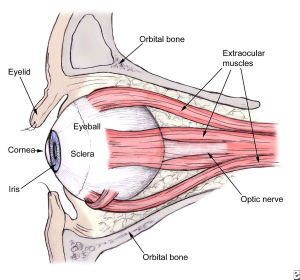|
Diplopia
Have you noticed double vision? Has this been a recent problem? You may be suffering from Double vision? What is Double Vision?
Diplopia is a term for double vision. It can indicate a neurological problem and can exist in one eye. Look at an object that you view as double. Now cover one eye. Is the object still double? Now cover the other eye. Does the object still look double? If the double vision persists after one eye is covered, then you have Monocular Diplopia, which means you have double vision in one eye only. This type is not a neurological problem. What are the causes?
The usual causes of Monocular Diplopia include: Thus, if you have Monocular Diplopia, you need to get a complete eye exam. Suppose your Double Vision is binocular (or involving both eyes). It can be horizontal or vertical. This means that the separation of the double images can be horizontal or vertical. Double Vision can be constant or intermittent. It can also be associated with other eye findings such as pupil and lid changes. What causes Binocular Double Vision?
Causes of Binocular Diplopia can include the following: Trauma: As a result of the eyes looking in different directions, you see double. With time, it may be difficult for you to control these eye movements and the eye turn “sticks”, so to speak. Sometimes, an external force such as a viral infection may make it difficult for you to control the eye turn. What should you know about Vertical Double Vision?
There are six extraocular muscles around each eye responsible for the eye movements you make. 
Vertical Diplopia is caused by the vertically acting muscles. Your eye doctor will ask you if the Double Vision gets worse or better on right or left gaze. Since the Double Vision gets worse in the field of action of the weak muscle, knowing the field of gaze in which the Double Vision is greatest helps your eye doctor narrow the choice to two muscles. The most common cause of head turns or tilts is ocular muscle imbalance. Old photographs of yourself are useful to see if the head turn or tilt had been there for a long time. By checking for head tilts, your eye doctor can narrow the choice to one muscle causing your Vertical Diplopia.
Can Eye Muscle Surgery Help?
Eye muscle surgery, otherwise known as strabismus surgery, can help correct Double Vision, if the it remains stable by repeated measurements for 6 months or more. This type of extraocular muscle surgery can be used for thyroid eye disease, among other causes. Cataract surgery can also help Double Vision. For example, cataract surgery done to equalize the spectacle prescriptions between the eyes can help. Another situation where cataract surgery may help double vision is when the surgeon deliberately decenters the implant in order to improve Vertical Diplopia. Can Myasthenia Gravis cause permanent Double Vision?When you are found to have a cranial nerve palsy that is not caused by a metabolic disorder like Diabetes or Hypertension, including cases of trauma, Myasthenia Gravis, Multiple Sclerosis, and brain tumors, the chance of complete recovery is decreased. Myasthenia Gravis is an autoimmune disease that frequently presents with eye movement problems. This disease does not affect the muscle or nerve directly, but it blocks the proper communication between the muscle and nerve by interrupting the neurotransmission junction. The appropriate neuromuscular transmission by way of acetylcholine is blocked by immunological complexes. Acetylcholine is a neurotransmitter that is released at nerve endings and used to conduct nerve impulses to cause muscle action. The most common eye finding is Ptosis (drooping lid). Eye movement difficulties with Double Vision are also frequently encountered with Myasthenia Gravis. The main feature of this disease is the variability of both the Ptosis and Double Vision (usually worse in the evening). Any changing Diplopia pattern, with or without Ptosis, should suggest this disease. Treatment of Myasthenia Gravis will involve some form of immunosuppression. This is a serious disease that can affect the entire body although it may first present with eye findings. If you only have eye findings for more than 2 years, the disease is likely to remain purely ocular. Double Vision can be very serious and so you should see your eye care provider and possibly a neurologist or neuro-ophthalmologist as soon as possible, especially if you confirm that your Double Vision is not Monocular Diplopia. |




